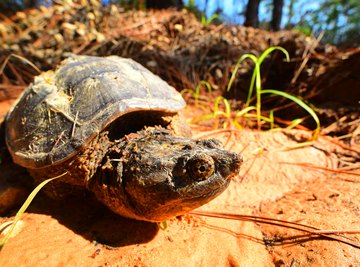
Snapping turtles are among the most impressively armed turtles in the world.
The common snapping turtle of the central and eastern U.S. and far southern Canada, and its close relatives the Central and South American snappers of the genus Chelydra, boast powerful hooked jaws, heavy claws, a sawtooth tail and a rugged shell.
The alligator snapping turtle, which belongs to a separate genus (Macrochelys), has a similarly formidable set of chompers and combines them with enormous size: big males may weigh more than 150 pounds, making them one of the very largest freshwater turtles in the world.
All things considered, it’s not surprising that the vast majority of snapping turtle predators target eggs, hatchlings or juveniles rather than adults.
Predators of Common Snapping Turtle Nests
Large numbers of snapping turtle eggs may be lost in a given area to nest-plunderers such as:
- fire ants
- rats
- raccoons
- skunks
- badgers
- opossums
- crows
- coyotes
- mink
Predators of Young Common Snappers
The diminutive size of a baby snapping turtle puts it at the mercy of quite the assortment of hunters.
Hatchling and juvenile common snappers can fall prey to large predatory fish such as largemouth and spotted bass, northern pike, muskellunge and gar as well as such semiaquatic serpents as cottonmouths and water snakes. Herons, egrets and other birds are also a threat, as are a range of mammalian carnivores: mink, river otters, raccoons, foxes, bobcats and others.
Young common snappers are also vulnerable to other snapping turtles, including alligator snappers in the American Southeast.
Predation on Adult Common Snapping Turtles
Once they reach decent size, common snapping turtles become too big and formidable for many of the predators that snatch up the eggs and the youngsters to deal with.
Indeed, few animals make a regular habit of preying on adult common snappers, although American alligators, black bears and perhaps alligator snappers occasionally do so.
River otters have been known to kill full-grown snappers during their winter hibernation. Human beings are by far the most significant predators of adult common snappers, which are widely trapped for their meat.
Predation on Neotropical Snapping Turtles
Less is known about the Central and South American snapping turtles, which for a long time were classified as one with the common snapper of North America. Eggs and hatchlings are likely preyed upon by a similarly diverse lineup of fish, birds, snakes and mammals.
Caimans – Central and South American relatives of alligators – probably take adult snappers occasionally, as might the jaguar, which is an enthusiastic predator of freshwater turtles with the big canines and powerful jaws needed to dismantle shells.
People collect both eggs and adult snappers in Central and South America for food.
Alligator Snapping Turtles
The eggs and hatchlings of alligator snapping turtles are preyed on by much the same suite of predators as common snappers. Given their massiveness, though, adult alligator snapping turtles are essentially immune to predation except from human beings.
Perhaps because their size and armor alone are effective defenses, alligator snappers are generally significantly less feisty and “snappy” than common snappers.
References
Resources
About the Author
Ethan Shaw is an independent naturalist and freelance outdoors/nature writer based in Oregon. He holds a B.S. in Wildlife Ecology and a graduate certificate in G.I.S. from the University of Wisconsin-Madison. His primary interests from both a fieldwork and writing perspective include landscape ecology, geomorphology, the classification of ecosystems, biogeography, wildlife/habitat relationships, and historical ecology. He’s written for a variety of outlets, including Earth Touch News, RootsRated, Backpacker, Terrain.org, and Atlas Obscura, and is presently working on a field guide.
